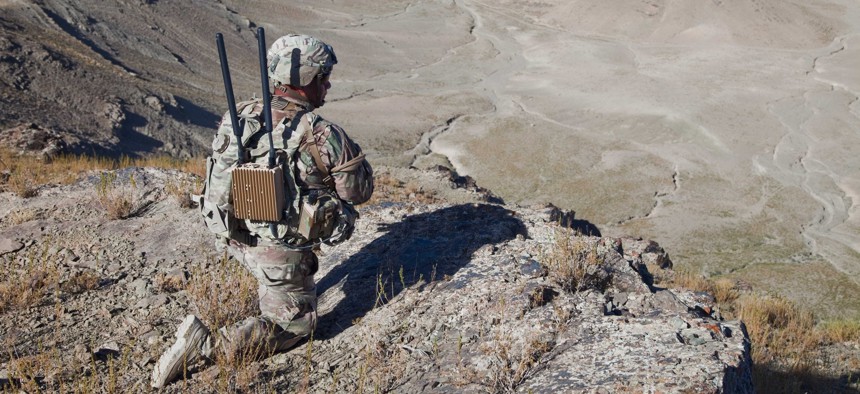
A U.S. Soldier of Bandit Troop 1st (Tiger) Squadron 3rd Cavalry Regiment provides overwatch security while soldiers move up Pride Rock mountain to witness the reenlistment of two U.S. Soldiers in Paktya province, Afghanistan. U.S. Army photo by Spc. Steven Cope
Time to Hit Pause on the US Army's Drawdown
The entire plan was built around the idea of an Iraq and Afghanistan 'post-war calm' that never really materialized.
Our Army needs to follow the sage advice of a popular adage: When you find yourself in a deep hole, stop digging.
The deep hole, in this case, is the Army’s continuing reduction in force structure and soldiers. Unless stopped, the Defense Department’s long-range plan will shrink the Army from its 2012 peak of 570,000 active-duty soldiers to 450,000 by 2018. To keep digging without stopping to look around would pose a risk to our nation and its interests, and could endanger our soldiers if they are called on to respond in situations where they lack the numbers, training and resources for the quick and decisive action we expect of our Army.
We need to hit the pause button on the drawdown, at least temporarily, to allow for a thorough reassessment of current and future threats, and for decisions to be made about capabilities the Army will need to carry out its missions.
The risks extend beyond one branch of the military. As the nation’s foundational force, the Army provides key capabilities across all of the services. Any gaps or flaws in the Army’s capabilities can affect Joint Force and coalition operations, widening the impact.
The Army drawdown began when it appeared the U.S. could withdraw most of its land forces from Iraq and Afghanistan, but there was a dangerous miscalculation because expected post-war calm never materialized. The strategic assessment underpinning the force cuts did not envision an aggressive Russia, the rise and depravity of the Islamic State group, and an increasingly unpredictable North Korea. It also did not envision that planned withdrawals of ground troops from Iraq and Afghanistan would be delayed by instability.
In its report to the president and Congress, the National Commission on the Future of the Army warned there doesn’t seem to be enough Army to go around. To minimize national risk, the eight-member panel recommended adding a tank brigade in Europe, keeping a forward-stationed aviation brigade in Korea, closing a number of shortfalls in current capabilities, and increasing investments in future capabilities.
To do what the National Commission recommends will require more money from Congress and the administration. The $148 billion requested for the Army in 2017 isn’t sufficient to provide the extra soldiers required for new units and to fill known shortfalls in critical battlefield capabilities. Without extra resources, the Army is on a downslope that will leave it smaller than the 980,000 Regular Army, Army Guard, and Army Reserve total that the National Commission says is the “minimum sufficient force necessary to meet the challenges of the future strategic environment.” This is reason for concern, and reason to stop cutting before significant harm is done.
As good stewards of America’s resources, and to treat with dignity and respect those who have stepped forward to serve our nation, the Army should hold end-strength steady at 475,000 soldiers in the Regular Army, 198,000 soldiers in the U.S. Army Reserve, and 342,000 soldiers in the Army National Guard. That would still be nearly 120,000 soldiers fewer than were needed for extended operations in Afghanistan and Iraq for much of the past 15 years, and would give defense planners time to comprehensively reassess the international security environment and the recommendations of the National Commission.
See also Defense One's latest annual report: State of Defense—Army
The alternative is to continue to downsize the Army, including pink slips to trained and experienced soldiers and their families, and then potentially turn back around and recruit, train and equip new soldiers—at considerable expense to the American public—to build the recommended new units and capabilities. Good stewardship of America’s resources demands that, to use another old adage, “measure twice and cut once.”




